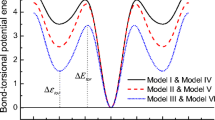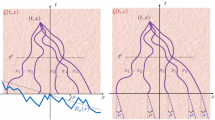Abstract
A flexible polymer chain under good solvent conditions, end-grafted on a flat repulsive substrate surface and compressed by a piston of circular cross-section with radius L may undergo the so-called “escape transition” when the height of the piston D above the substrate and the chain length N are in a suitable range. In this transition, the chain conformation changes from a quasi-two-dimensional self-avoiding walk of “blobs” of diameter D to an inhomogeneous “flower” state, consisting of a “stem” (stretched string of blobs extending from the grafting site to the piston border) and a “crown” outside of the confining piston. The theory of this transition is developed using a Landau free-energy approach, based on a suitably defined (global) order parameter and taking also effects due to the finite chain length N into account. The parameters of the theory are determined in terms of known properties of limiting cases (unconfined mushroom, chain confined between infinite parallel walls). Due to the non-existence of a local order parameter density, the transition has very unconventional properties (negative compressibility in equilibrium, non-equivalence between statistical ensembles in the thermodynamic limit, etc.). The reasons for this very unusual behavior are discussed in detail. Using Molecular Dynamics (MD) simulation for a simple bead-spring model, with N in the range 50 \( \leq\) N \( \leq\) 300 , a comprehensive study of both static and dynamic properties of the polymer chain was performed. Even though for the considered rather short chains the escape transition is still strongly rounded, the order parameter distribution does reveal the emerging transition clearly. Time autocorrelation functions of the order parameter and first passage times and their distribution indicate clearly the strong slowing down associated with the chain escape. The theory developed here is in good agreement with all these simulation results.
Similar content being viewed by others
Explore related subjects
Discover the latest articles, news and stories from top researchers in related subjects.References
W. Baumgartner, P. Hinterdorfer, W. Ness, A. Raab, D. Vechweber, H. Schindler, D. Drenckhahn, Proc. Natl. Acad. Sci. U.S.A. 97, 4005 (2000).
T. Hugel, M. Grasholz, H. Clausen-Schaumann, A. Pfau, H. Gaub, M. Seitz, Macromolecules 34, 1039 (2001).
T. Hugel, M. Seitz, Macromol. Chem. Rapid. Commun. 22, 989 (2001).
H. Clausen-Schaumann, M. Seitz, R. Krautbauer, H.E. Gaub, Curr. Opin. Chem. Biol. 4, 524 (2001).
M.C. Williams, I. Rouzina, Curr. Opin. Struct. Biol. 12, 330 (2002).
P.G. de Gennes, Scaling Concepts in Polymer Physics (Cornell University Press, Ithaca, New York, 1979).
G. Subramanian, D.R.M. Williams, P.A. Pincus, Europhys. Lett. 29, 285 (1995)
D.R.M. Williams, F.C. MacKintosh, J. Phys. II 5, 1407 (1995).
M.C. Gufford, D.R.M. Williams, E.M. Sevick, Langmuir 21, 5691 (1997).
J. Jimenez, R. Rajagopalan, Langmuir 14, 2598 (1998).
E.M. Sevick, D.R.M. Williams, Macromolecules 32, 6841 (1999).
A. Milchev, V. Yamakov, K. Binder, Phys. Chem. Chem. Phys. 1, 2083 (1999)
J. Ennis, E.M. Sevick, D.R.M. Williams, Phys. Rev. E 60, 6906 (1999).
J. Ennis, E.M. Sevick, Macromolecules 34, 1908 (2001).
E.M. Sevick, Macromolecules 33, 5743 (2000).
B.M. Steels, F.A.M. Leermakers, C.A. Haynes, J. Chromatogr. B 743, 31 (2000).
F.A.M. Leermakers, A.A. Gorbunov, Macromolecules 35, 8640 (2002).
A.M. Skvortsov, L.I. Klushin, F.A.M. Leermakers, Europhys. Lett. 58, 292 (2002).
L.I. Klushin, A.M. Skvortsov, F.A.M. Leermakers, Phys. Rev. E 69, 061101 (2004).
F.A.M. Leermakers, A.M. Skvortsov, L.I. Klushin, J. Stat. Mech. 10001, 1 (2004).
A.M. Skvortsov, L.I. Klushin, F.A.M. Leermakers, Macromol. Symp. 237, 73 (2006)
M. Daoud, P.G. de Gennes, J. Phys. (Paris) 38, 85 (1977).
H.P. Hsu, K. Binder, L.I. Klushin, A.M. Skvortsov, Phys. Rev. E 76, 021108 (2007).
J. Abbou, A. Anne, K. Demaille, J. Phys. Chem. 110, 22664 (2006).
L.F. Braganza, D.L. Worcester, Biochemistry 25, 7484 (1986).
T.L. Hill, Statistical Mechanics, Principles and Selected Applications (McGraw-Hill Book Co., New York, 1956).
R. Balescu, Equilibrium and Nonequilibrium Statistical Mechanics (John Wiley and Sons, New York-London-Sydney-Toronto, 1975).
G.S. Grest, K. Kremer, Phys. Rev. A 33, 3628 (1986).
K. Binder (Editor), Monte Carlo and Molecular Dynamics Simulations in Polymer Science (Oxford University Press, New York, 1995).
M. Kotelyanskii, D.N. Theodoru, Computer Simulation Methods for Polymers (M. Dekker, New York, 2004).
M.P. Allen, D.J. Tildesley, Computer Simulations of Liquids (Clarendon Press, Oxford, 1987).
H.P. Hsu, P. Grassberger, J. Chem. Phys. 120, 2034 (2004).
J. des Cloizeaux, G. Jannink, Polymers in Solutions: Their Modeling and Structure (Clarendon, Oxford, 1990).
S. Caracciolo, M.S. Causo, A. Pellissetto, J. Phys. A 32, 1215 (1998).
T. Kreer, S. Metzger, M. Muller, K. Binder, J. Chem. Phys. 120, 4012 (2004).
D.I. Dimitrov, A. Milchev, K. Binder, L.I. Klushin, A.M. Skvortsov, J. Chem. Phys. 128, 234902 (2008).
A. Milchev, K. Binder, Eur. Phys. J. B 3, 477 (1998)
L.D. Landau, E.M. Lifshitz, Statistical Physics (Pergamon, London, 1980).
D. Ruelle, Statistical Mechanics: Rigorous Results (Benjamin, New York-Amsterdam, 1969).
M.E. Fisher, The Nature of Critical Points (University of Colorado Press, Colorado, 1965).
K. Binder, Rep. Progr. Phys. 50, 783 (1987).
R.B. Griffiths, C.-Y. Wang, L.S. Langer, Phys. Rev. 149, 301 (1966).
W. Paul, D.W. Heermann, K. Binder, J. Phys. A 22, 3325 (1989).
R.B. Bird, C.F. Curtiss, R.C. Armstrong, O. Hassager, Dynamics of Polymeric Liquids, Vol. 2, Kinetic Theory (John Wiley and Sons, New York, 1987).
M. Doi, S.F. Edwards, The Theory of Polymer Dynamics (Oxford University Press, Oxford, 1988).
B. Maier, J.O. Radler, Phys. Rev. Lett. 82, 1911 (1999).
H. Risken, The Fokker-Planck Equation (Springer-Verlag, Berlin, 1989).
D.H.E. Gross, Microcanonical Thermodynamics (World Scientific, Singapore, 2001).
Author information
Authors and Affiliations
Corresponding author
Rights and permissions
About this article
Cite this article
Dimitrov, D.I., Klushin, L.I., Skvortsov, A. et al. The escape transition of a polymer: A unique case of non-equivalence between statistical ensembles. Eur. Phys. J. E 29, 9–25 (2009). https://doi.org/10.1140/epje/i2008-10442-0
Received:
Accepted:
Published:
Issue Date:
DOI: https://doi.org/10.1140/epje/i2008-10442-0




